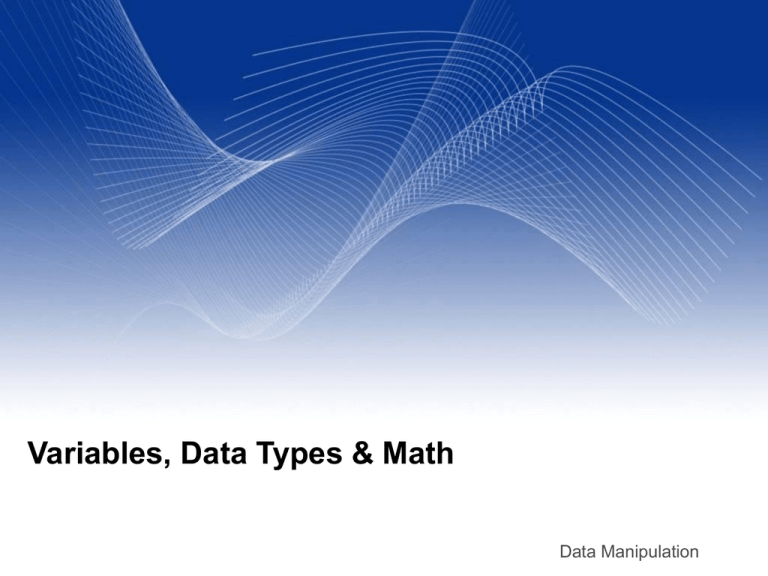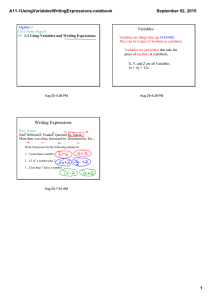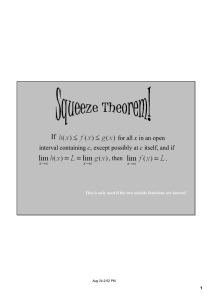Variables, Data Types & Math Data Manipulation
advertisement

Variables, Data Types & Math Data Manipulation Variables • • • A variable is a name (identifier) that points to a value. They are useful to store values, and to refer to changing values by the same name. To create a variable, simply name it and assign it a value to point to with the assignment operator (single equal sign) >>> myName = “Jay” myName Aug 29 2007 “Jay” 2 Variables A variable name can be made up of letters, numbers, and the underscore ( _ ) character. • The first character must be a letter. • Variable names are case sensitive (myName and myname are different). >>> myname = “robot” • myname “robot” myName “Jay” Aug 29 2007 3 Variables >>> number1 = 3 >>> number2 = 2 >>> 3rdnumber = 5 Syntax Error: invalid syntax >>> import = 7 Syntax Error: invalid syntax number1 3 number2 2 Aug 29 2007 4 Using Variables When python sees a variable name, it evaluates the variable (sees what it points to) and uses the value that the variable points to instead of the variable name. >>> myName 'Jay' >>> number1 3 • myName “Jay” number1 3 Aug 29 2007 5 Using Variables • If the python interpreter finds an identifier or variable name that has not yet been defined, it will return an error. >>> aRandomName NameError: name 'aRandomName' is not defined myName “Jay” number1 3 Aug 29 2007 6 Using Variables You can do math with variables that point to numbers. • The python interpreter evaluates the variables by checking to see what number (value) they are pointing to, and then uses that value for the math. >>> 3 + 2 5 number2 >>> number1 + number2 5 • 2 number1 3 Aug 29 2007 7 Using Variables You can even store the answer in a new variable. >>> answer = number1 + number 2 • answer 5 number2 2 number1 3 Aug 29 2007 8 Using Variables Variables can be re-assigned: >>> print( myName ) 'Jay' >>> • myName Aug 29 2007 “Jay” 9 Using Variables Variables can be re-assigned: >>> print( myName ) 'Jay' >>> myName = “Robot” >>> print( myName ) 'Robot' • myName “Jay” “Robot” Aug 29 2007 10 Using Variables Variables can be passed to functions as arguments >>> forward( 1, 0.5) • Is equivalent to: >>> speed = 1 >>> time = 0.5 >>> forward( speed, time) • The python interpreter creates the two variables (speed and time) for use in the forward() function. When the forward() function uses these variables, they evaluate to 1 and 0.5 • speed time Aug 29 2007 1 0.5 11 Data Types • • When values are stored in a computer, they have different data types. So far, we have seen two types of values, Strings and Integers. – – – • Strings are made up of one or more characters. We place them in quotes to indicate that they are a string. >>> “Jay” Integers are numbers without fractional components, such as -2, or 7. Aug 29 2007 12 Data Types Python has a special function called type() that returns the type of any value. • Strings and Integers are abbreviated 'str' and 'int' >>> type(7) <type 'int'> >>> type( “Hi”) <type 'str'> • Aug 29 2007 13 Data Types When you use type() on a variable, python evaluates the variable to see what value it points at, and then gives that value to the type() function. • The type() function returns the type of the value. >>> answer = 5 >>> type(answer) <type 'int'> >>> answer = “Jay” >>> type(answer) <type 'str'> • Aug 29 2007 14 Math with Integers Python includes standard mathematical operators (addition, subtraction, multiplication and division) represented with (+, -, *, / ) >>> 3-2 1 >>> 7 * 5 35 >>>100 / 5 20 >>> 10 / 3 3.33333333 • Aug 29 2007 15 Integer Division vs Floating Point Division >>> 10.0 / 3.0 3.33333333335 • In python 3, division produces floating point results by default. If you want to only have integer results (integer division) you must use the special integer division operator, which is a double slash. >>> 10 // 3 3 Aug 29 2007 16 Question for you: Order of Operations What result is stored in answer? >>> answer = 5 * 10 + 2 • Aug 29 2007 17 Order of Operations What result is stored in answer? >>> answer = 5 * 10 + 2 >>> print(answer) 52 • Python follows normal mathematical rules for order of operations. • Multiplication and Division happen before Addition and Subtraction. • You can use parenthesis () to make parts of an expression evaluate first >>> answer = 5 * ( 10 + 2) >>> print(answer) 60 • Aug 29 2007 18 Order of Operations Note that the assignment operator (single equal sign) happens AFTER all of the other math operators. • This only matters if a variable appears on both sides of the assignment operator. >>> answer = 10 >>> answer = answer + 5 • 10 answer Aug 29 2007 19 Order of Operations Note that the assignment operator (single equal sign) happens AFTER all of the other math operators. • This only matters if a variable appears on both sides of the assignment operator. >>> answer = 10 >>> answer = answer + 5 >>> print( answer ) 15 • The Python interpreter evaluates the answer variable (on the right side of the assignment operator) and finds the integer value 10. It then adds 10 to 5, producing 15. Only then does it assign the 15 to the answer variable (on the left side of the assignment operator). • answer Aug 29 2007 10 15 20 Math with Strings! In normal math you can't do math with strings. • In python, the addition and multiplication (+,*) operators have been overloaded to have meaning when used with strings. • Adding two strings results in their concatenation >>> “Hello” + “There” 'HelloThere' >>> “Hello” + “ “ + “There” 'Hello There” • Aug 29 2007 21 Math with Strings! Multiplication can be represented as multiple addition: • 7 * 3 = 7 + 7 + 7 = 21 • So multiplication of a string by a number can be represented as multiple concatenation: • “Boo!” * 3 = “Boo!” + “Boo!” + “Boo!” = “Boo!Boo!Boo!” >>> “Boo!” * 3 'Boo!Boo!Boo!' • Aug 29 2007 22 Data Types MATTER! >>> 3 + 5 8 >>> “3” + “5” '35' • Notice the difference between adding two numbers and adding two single character strings! • Because operators can have different behaviors depending upon the data type of their operands, it is important to understand what data type the value you are working with is! Aug 29 2007 23 Math with Variables Any place where you have a value, you can instead use a variable that points to that value. area = 3.14159 * 10 * 10 • is equivalent to: >>>pi = 3.14159 >>>r = 10 >>>area = pi * r * r • Any time a function returns a value, you can assign it to a variable to store it, and then use that variable later. >>> robotName = getName() >>> statement = “My Robots Name is: “ + robotName >>> print(statement) 'My Robots Name is: Scribby' • Aug 29 2007 24 Summary • • When stored in a computer, all values have an associated Data Type. Data types we have seen so far (others exist): – – – • • • int – Integers, numbers without fractional parts str – Strings, represented by placing characters in “quotes” float – Numbers with fractional parts Variables are names (identifiers) that can point to values. The assignment operator (=) is used to make a variable point to a value. Math in python uses many standard operators that you are familiar with (+,-,*,/). Aug 29 2007 25




